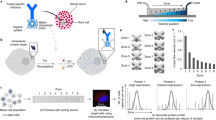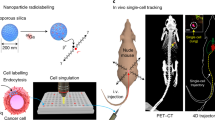Abstract
The spread of cancer cells between organs, a process known as metastasis, is the cause of most cancer deaths1,2. Detecting circulating tumour cells—a common marker for the development of metastasis3,4—is difficult because ex vivo methods are not sensitive enough owing to limited blood sample volume and in vivo diagnosis is time-consuming as large volumes of blood must be analysed5,6,7. Here, we show a way to magnetically capture circulating tumour cells in the bloodstream of mice followed by rapid photoacoustic detection. Magnetic nanoparticles, which were functionalized to target a receptor commonly found in breast cancer cells, bound and captured circulating tumour cells under a magnet. To improve detection sensitivity and specificity, gold-plated carbon nanotubes conjugated with folic acid were used as a second contrast agent for photoacoustic imaging. By integrating in vivo multiplex targeting, magnetic enrichment, signal amplification and multicolour recognition, our approach allows circulating tumour cells to be concentrated from a large volume of blood in the vessels of tumour-bearing mice, and this could have potential for the early diagnosis of cancer and the prevention of metastasis in humans.
This is a preview of subscription content, access via your institution
Access options
Subscribe to this journal
Receive 12 print issues and online access
$259.00 per year
only $21.58 per issue
Buy this article
- Purchase on Springer Link
- Instant access to full article PDF
Prices may be subject to local taxes which are calculated during checkout





Similar content being viewed by others
References
Christofori, G. New signals from the invasive front. Nature 441, 444–450 (2006).
Pantel, K., Brakenhoff, R. H. & Brandt, B. Detection, clinical relevance and specific biological properties of disseminating tumour cells. Nature Rev. Cancer 8, 329–340 (2008).
Nagrath, S. et al. Isolation of rare circulating tumor cells in cancer patients by microchip technology. Nature 450, 1235–1239 (2007).
Riethdorf, S. et al. Detection of circulating tumor cells in peripheral blood of patients with metastatic breast cancer: a validation study of the CellSearch system. Clin. Cancer Res. 13, 920–928 (2007).
Georgakoudi, I. et al. In vivo flow cytometry: a new method for enumerating circulating cancer cells. Cancer Res. 64, 5044–5047 (2004).
Zharov, V. P., Galanzha, E. I., Shashkov, E. V., Khlebtsov, N. & Tuchin, V. In vivo photoacoustic flow cytometry for monitoring circulating single cancer cells and contrast agents. Opt. Lett. 31, 3623–3625 (2006).
He, W., Wang, H., Hartmann, L. C., Cheng, J. X. & Low, P. S. In vivo quantitation of rare circulating tumor cells by multiphoton intravital flow cytometry. Proc. Natl Acad. Sci. USA 104, 11760–11765 (2007).
Heyn, C. et al. In vivo magnetic resonance imaging of single cells in mouse brain with optical validation. Magn. Reson. Med. 55, 23–29 (2006).
Medarova, Z., Pham, W., Kim, Y., Dai, G. & Moore, A. In vivo imaging of tumor response to therapy using a dual-modality imaging strategy. Int. J. Cancer 118, 2796–2802 (2006).
Larson, T. A., Bankson, J., Aaron, J. & Sokolov, K. Hybrid plasmonic magnetic nanoparticles as molecular specific agents for MRI/optical imaging and photothermal therapy of cancer cells Nanotechnology 18, 325101 (2007).
Kim, D. H., Kim, K. N., Kim, K. M. & Lee, Y. K. Targeting to carcinoma cells with chitosan- and starch-coated magnetic nanoparticles for magnetic hyperthermia. J. Biomed. Mater. Res. A 88, 1–11 (2009).
McCarthy, J. R., Kelly, K. A., Sun, E. Y. & Weissleder, R. Targeted delivery of multifunctional magnetic nanoparticles. Nanomedicine 2, 153–167 (2007).
Muthana, M. et al. A novel magnetic approach to enhance the efficacy of cell-based gene therapies. Gene Ther. 15, 902–910 (2008).
Polyak, B. et al. High field gradient targeting of magnetic nanoparticle-loaded endothelial cells to the surfaces of steel stents. Proc. Natl Acad. Sci. USA 105, 698–703 (2008).
Xia, N. et al. Combined microfluidic–micromagnetic separation of living cells in continuous flow. Biomed. Microdev. 8, 299–308 (2006).
Benez, A., Geiselhart, A., Handgretinger, R., Schiebel, U. & Fierlbeck, G. Detection of circulating melanoma cells by immunomagnetic cell sorting. J. Clin. Lab. Anal. 13, 229–233 (1999).
Pamme, N. Magnetism and microfluidics. Lab Chip. 6, 24–38 (2006).
Zhang, H. F., Maslov, K., Stoica, G. & Wang, L. V. Functional photoacoustic microscopy for high-resolution and noninvasive in vivo imaging. Nature Biotechnol. 24, 848–851 (2006).
Zerda, A. et al. Carbon nanotubes as photoacoustic molecular imaging agents in living mice. Nature Nanotech. 3, 557–562 (2008).
Zharov, V. P. et al. Photoacoustic flow cytometry: principle and application for real-time detection of circulating single nanoparticles, pathogens and contrast dyes in vivo. J. Biomed. Opt. 12, 051503 (2007).
Galanzha, E. I, Shashkov, E. V., Tuchin, V. V. & Zharov, V. P. In vivo multispectral, multiparameter photoacoustic lymph flow cytometry with natural cell focusing, label-free detection and multicolor nanoparticle probes. Cytometry 73, 884–894 (2008).
Galanzha, E. I., Shashkov, E. V., Spring, P. M., Suen, J. Y. & Zharov, V. P. In vivo, noninvasive label-free detection and eradication of circulating metastatic melanoma cells using two-color photoacoustic flow cytometry with a diode laser. Cancer Res. 69, 7926–7934 (2009).
Kämmerer, U., Thanner, F., Kapp, M., Dietl, J. & Sütterlin, M. Expression of tumor markers on breast and ovarian cancer cell lines. Anticancer Res. 23, 1051–1055 (2003).
Stoeva, S. I., Lee, J. S., Smith, J. E., Rosen, S. T. & Mirkin, C. A. Multiplexed detection of protein cancer markers with biobarcoded nanoparticle probes. J. Am. Chem. Soc. 128, 8378–8379 (2006).
Li, P. C. et al. Photoacoustic imaging of multiple targets using gold nanorods. IEEE Trans. Ultrason. Ferroelectr. Freq. Control 54, 1642–1647 (2007).
Yang, L. et al. Development of receptor targeted magnetic iron oxide nanoparticles for efficient drug delivery and tumor imaging. Special Issue on Cancer Nanotechnology. J. Biomed. Nanotechnol. 4, 439–449 (2008).
Yang, L. et al. Receptor-targeted nanoparticles for in vivo imaging of breast cancer. Clin. Cancer Res. 15, 4722–4732 (2009).
Kim, J.-W., Galanzha, E. I., Shashkov, E. V., Moon, H.-M. & Zharov, V. P. Golden carbon nanotubes as multimodal photoacoustic and photothermal high-contrast molecular agents. Nature Nanotech. 4, 688–694 (2009).
Bulte, J. W. & Kraitchman, M. Iron oxide MR contrast agents for molecular and cellular imaging. NMR Biomed. 17, 484–499 (2004).
Clement, J. H. et al. Different interaction of magnetic nanoparticles with tumor cells and peripheral blood cells. J. Cancer Res. Clin. Oncol. 132, 287–292 (2006).
Petrov, Y. Y., Petrova, I. Y., Patrikeev, I. A., Esenaliev, R. O. & Prough, D. S. Multiwavelength optoacoustic system for noninvasive monitoring of cerebral venous oxygenation: a pilot clinical test in the internal jugular vein. Opt. Lett. 31, 1827–1829 (2006).
Ermilov, S. A. et al. Laser optoacoustic imaging system for detection of breast cancer. J. Biomed. Opt. 14, 024007 (2009).
Acknowledgements
This work is supported in part by National Institute of Health grant numbers R01EB000873, R01CA131164, R01 EB009230, R21EB0005123 and R21CA139373 (V.P.Z.), National Cancer Institute grant number CA133722 (L.Y.), National Science Foundation grant numbers DBI-0852737 (V.P.Z.) and CMMI-0709121 (J.-W.K.) and the Arkansas Biosciences Institute (J.-W.K. and V.P.Z.). The authors would like to thank Y.A. Wang of Ocean Nanotech, LLC, for providing MNPs, H.-M. Moon for his assistance with GNT synthesis, J. Daniels for cell culturing, Z. Cao for bioconjugation of MNPs and cell labelling, H.K. Sajja for production of human amino-terminal fragments of urokinase plasminogen activator, H. Mao for magnetic resonance imaging and S. Fergusson for his assistance with laser measurements.
Author information
Authors and Affiliations
Contributions
E.I.G. and V.P.Z. conceived and designed the experiments. J.-W.K was responsible for GNT synthesis and their characterization and bioconjugation, L.Y. for conjugation and characterization of MNPs, T.K. for providing assessments of cancer cells and E.I.G. and E.V.S. for the remaining experiments. All authors discussed the results. V.P.Z., E.I.G. and J.-W.K. co-wrote the paper with editorial comments from L.Y. and T.K.
Corresponding author
Supplementary information
Supplementary information
Supplementary information (PDF 1302 kb)
Rights and permissions
About this article
Cite this article
Galanzha, E., Shashkov, E., Kelly, T. et al. In vivo magnetic enrichment and multiplex photoacoustic detection of circulating tumour cells. Nature Nanotech 4, 855–860 (2009). https://doi.org/10.1038/nnano.2009.333
Received:
Accepted:
Published:
Issue Date:
DOI: https://doi.org/10.1038/nnano.2009.333
This article is cited by
-
Nanomaterial-Based Scaffolds for Tissue Engineering Applications: A Review on Graphene, Carbon Nanotubes and Nanocellulose
Tissue Engineering and Regenerative Medicine (2023)
-
Towards rainbow portable Cytophone with laser diodes for global disease diagnostics
Scientific Reports (2022)
-
Water-powered self-propelled magnetic nanobot for rapid and highly efficient capture of circulating tumor cells
Communications Chemistry (2021)
-
Dynamic blood flow phantom for in vivo liquid biopsy standardization
Scientific Reports (2021)
-
Nanostructure Materials: Efficient Strategies for Circulating Tumor Cells Capture, Release, and Detection
Biotechnology and Bioprocess Engineering (2021)



